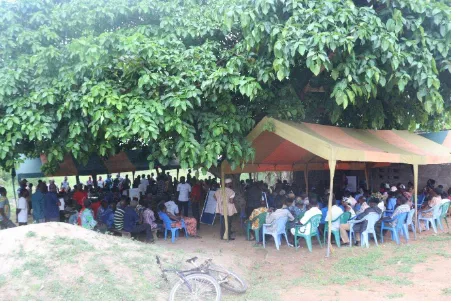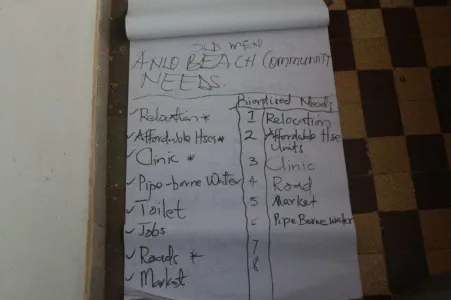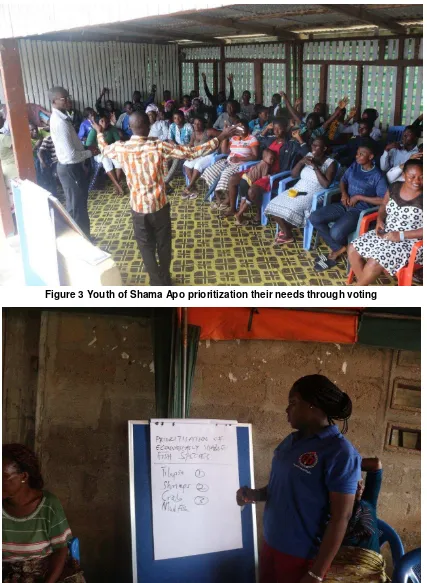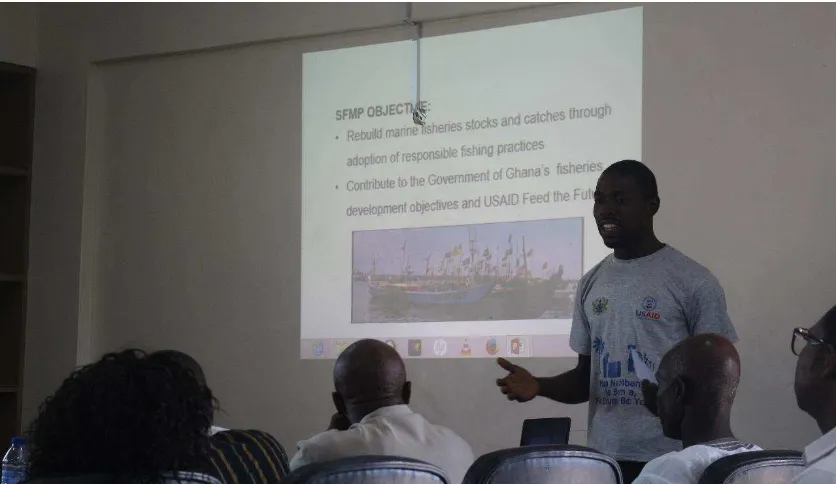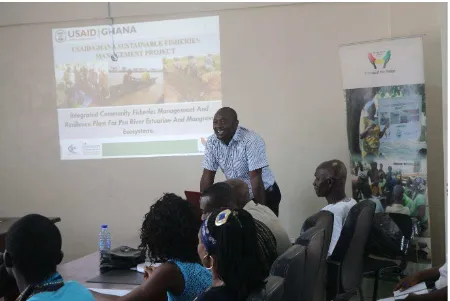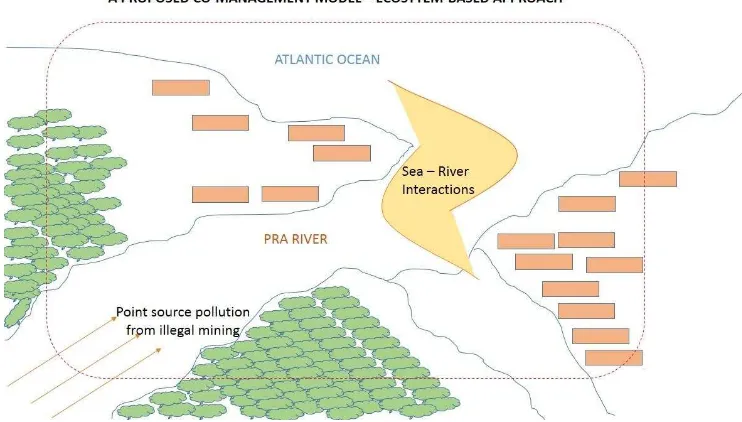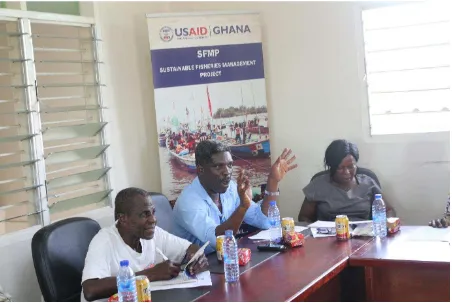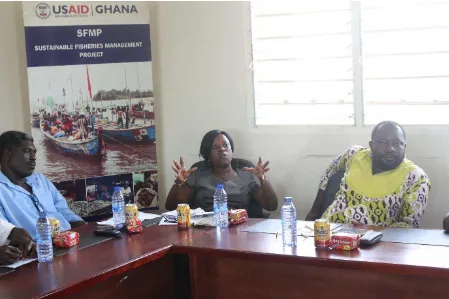SUSTAINABLE FISHERIES
MANAGEMENT PROJECT (SFMP)
Initiating governance mechanisms
with Shama District on Pra
Resilience Planning process
This publication is available electronically in the following locations: The Coastal Resources Center
http://www.crc.uri.edu/projects_page/ghanasfmp/
Ghanalinks.org
https://ghanalinks.org/elibrary search term: SFMP USAID Development Clearing House
https://dec.usaid.gov/dec/content/search.aspx search term: Ghana SFMP
For more information on the Ghana Sustainable Fisheries Management Project, contact:
USAID/Ghana Sustainable Fisheries Management Project Coastal Resources Center
Graduate School of Oceanography University of Rhode Island
220 South Ferry Rd.
Narragansett, RI 02882 USA
Tel: 401-874-6224 Fax: 401-874-6920 Email: [email protected]
Citation: Friends of the Nation (2017). Initiating governance mechanisms with Shama District on Pra Resilience Planning process. The USAID/Ghana Sustainable Fisheries Management Project (SFMP). Narragansett, RI: Coastal Resources Center, Graduate School of Oceanography, University of Rhode Island and Friends of the Nation. GH2014_ACT144_FoN. 30 pp.
Authority/Disclaimer:
Prepared for USAID/Ghana under Cooperative Agreement (AID-641-A-15-00001), awarded on October 22, 2014 to the University of Rhode Island, and entitled the USAID/Ghana Sustainable Fisheries Management Project (SFMP).
This document is made possible by the support of the American People through the United States Agency for International Development (USAID). The views expressed and opinions contained in this report are those of the SFMP team and are not intended as statements of policy of either USAID or the cooperating organizations. As such, the contents of this report are the sole responsibility of the SFMP team and do not necessarily reflect the views of USAID or the United States Government.
Detailed Partner Contact Information:
USAID/Ghana Sustainable Fisheries Management Project (SFMP) 10 Obodai St., Mempeasem, East Legon, Accra, Ghana
Telephone: +233 0302 542497 Fax: +233 0302 542498
Maurice Knight Chief of Party [email protected]
Kofi Agbogah Senior Fisheries Advisor [email protected] Nii Odenkey Abbey Communications Officer [email protected]
Bakari Nyari Monitoring and Evaluation Specialist [email protected] Brian Crawford Project Manager, CRC [email protected]
Ellis Ekekpi USAID AOR (acting) [email protected]
SNV Netherlands Development Organisation #161, 10 Maseru Road,
E. Legon, Accra, Ghana 233 30 701 2440
Donkris Mevuta Kyei Yamoah [email protected] Friends of the Nation Parks and Gardens Adiembra-Sekondi, Ghana
Darkuman Junction, Kaneshie Odokor Highway
Accra, Ghana 233 302 315894
For additional information on partner activities: CRC/URI: http://www.crc.uri.edu CEWEFIA: http://cewefia.weebly.com/
DAA: http://womenthrive.org/development-action-association-daa Friends of the Nation: http://www.fonghana.org
Hen Mpoano: http://www.henmpoano.org
ACRONYMS
CCM Centre for Coastal Management
CEWEFIA Central and Western Region Fishmongers Improvement Association CRC Coastal Resource Center
CSLP Coastal Sustainable Landscape Project DAA Development Action Association
DFAS Department of Fisheries and Aquatic Science DMFS Department of Marine Fisheries Sciences DQF Daasgift Quality Foundation
FtF Feed the Future
GIFA Ghana Inshore Fishermen's Association GIS Geographic Information System
GNCFC Ghana National Canoe Fishermen’s Council
HM Hen Mpoano
ICFG Integrated Coastal and Fisheries Governance MESTI Ministry of Environment Science and Technology MOFAD Ministry of Fisheries and Aquaculture Development NDPC National Development Planning Commission
NGOs Non-Governmental Organizations
SFMP Sustainable Fisheries Management Project SMEs Small and Medium Enterprises
SNV Netherlands Development Organization
SSG SSG Advisors
STWG Scientific and Technical Working Group UCC University of Cape Coast
URI University of Rhode Island
TABLE OF CONTENTS
Contents
ACRONYMS ... iii
TABLE OF CONTENTS ... iv
LIST OF FIGURES ... v
LIST OF TABLES ... v
EXECUTIVE SUMMARY ... 1
BACKGROUND ... 1
GROUPINGS AND PRA PROCESSES ... 3
Needs Identification ... 3
Prioritization ... 4
Harmonization... 5
OUTCOMES OF THE PRA ... 6
Management Area ... 6
Riverine and Estuarine Fish Species to Concentrate Management Actions ... 6
GENERAL COMMUNITY NEEDS ... 6
Anlo Beach... 7
Shama Apo ... 7
OTHER IDENTIFIED COMMUNITIES ... 7
STAKEHOLDERS MEETINGS INITIATING GOVERNANCE MECHANISMS WITH SHAMA DISTRICT ... 8
Objectives of Meeting ... 8
Expected outcomes ... 8
Structure of Meeting ... 8
OVERVIEW OF SFMP ... 8
RESILIENCE PLANNING EFFORTS ... 9
CO-MANAGEMENT APPROACH AND EXPECTED ROLES OF STAKEHOLDERS ... 9
Co-Management Approach ... 10
Expected Mandates ... 11
RELEVANT INSTITUTIONAL LINKAGES ... 11
VISION BUILDING EXERCISE... 15
Site Visits ... 15
Round Table Discussions ... 15
Rapid Assessment ... 17
Methodology ... 17
Identified Fish Species ... 19
Jurisdictional Mapping... 23
NEXT STEPS ... 24
LIST OF FIGURES
Figure 1 Showing a cross-section of participants in Anlo Beach ... 3Figure 2 Showing 8 needs by elderly men of Anlo Beach ... 4
Figure 3 Youth of Shama Apo prioritization their needs through voting ... 5
Figure 4 Showing prioritised fish species by women of Anlo Beach ... 5
Figure 5 Showing a woman from Shama Apo making a comment on their prioritized needs .. 6
Figure 6 Philip Prah of FoN presenting the objectives of SFMP ... 9
Figure 7 Theophilus Boachie-Yiadom of FoN presenting on the co-management approach .. 10
Figure 8 A proposed co-management model designed through community participation ... 11
Figure 9 A group of participants discussing on relevant institutional linkages ... 12
Figure 10 A group member presenting the outcome of discussions ... 12
Figure 11 Representative of Education department explaining the need for schools’ inclusion in the co-management process ... 13
Figure 12 Director of Agriculture making a submission ... 13
Figure 13 Representative of Community Development making a submission ... 14
Figure 14 Chairman of the Agriculture and Coastal Resources Management Sub-committee making a submission ... 14
Figure 15 Some committee members observing issues along the river banks ... 15
Figure 16 Officers from Environmental Protection Agency and Fisheries Commission fine-tuning the vision for the committee ... 16
Figure 17 FoN staff explaining the SFMP concept and the rationale for co-management to a group of young women prior to questioning... 18
Figure 18 Burrito... 21
Figure 19 Long-finned herring... 21
Figure 20 Atlantic Bumper ... 22
Figure 21 Flat Sardinella ... 22
Figure 22 Showing distance between river banks and the nearest building in Anlo Beach .... 23
Figure 23 Showing the distance between the lowest tidal mark and the highest tidal mark at Anlo Beach... 23
LIST OF TABLES
EXECUTIVE SUMMARY
Initiating governance mechanisms with Shama District on Pra Resilience Planning process is crucial for the sustained conservation of the Pra River Estuary.
Therefore, FoN organized series of meetings and field visits with stakeholders in the Shama District to discuss the Pra Resilience Planning process and the development of the Pra
Estuary’s Area Fisheries Co-Management.
The meetings provided the platform to brief the district level stakeholders about the progress of the Pra fisheries co-management pilot process. The following stakeholder institutions were engaged; the Shama District Assembly, Environmental Protection Agency (EPA), Wildlife Division of the Forestry Commission, Fisheries Commission, Traditional Leaders NADMO, the Pra Community leaders, etc.
The meetings discussed how to strengthen the governance mechanisms in the District and recommended that Town and Country planning program and GIS capability within the Shama District Assembly should be used to support the co-management process for the Pra estuary by providing various maps and other services.
Key output of the meetings also included the identification of the key institutions (i.e. Fisheries Commission, Shama District Assembly, EPA, Wildlife Division, Traditional Leaders, CSOs, University of Cape-Coast, etc.) that will support the implementation of the fisheries co-management plan. These meeting also provided the platform to draft the roles and responsibilities of the identified stakeholders and strategies for the fisheries
co-management plan.
BACKGROUND
Communities fringing the Pra river estuary derive majority of their livelihoods from the wetlands and other natural resources within the enclave. Local knowledge from the
communities indicates a rapid decline in fish catch both from the Pra river estuarine system and the surrounding seas. This has been attributed to the over-dependence and improper management of the resources, their habitats and surrounding environments. This as a result is contributing to increased vulnerabilities of these coastal communities as the day goes by; and may have adverse effects on future livelihoods. Carney (1998: 4) explains that a livelihood is sustainable when it can cope with and recover from stress and shocks and maintain or
enhance its capabilities and assets both now and in the future, while not undermining the
natural resource base’. Trying to attain such sustainable livelihood including the fisheries in
the nearest future, seven communities surrounding the Pra river estuary tasked the two closest and most affected communities, Anlo Beach and Shama Apo, to jointly initiate management efforts which will eventually support the rebuilding of riverine and marine fisheries stocks. In the year 2 of the Sustainable Fisheries Management Project (SFMP), actions to promote ecosystem-based fisheries management and community resilience planning were initiated in the Pra river estuarine area. In addition, Socio-ecological profiling, SWOT analyses of key stakeholder institutions, alternative livelihood assessment, and vulnerability assessment were conducted.
The need for a citizens-owned co-management agenda towards the management of the Pra estuarine area was emphasized. Two communities, Anlo Beach and Shama Apo, were tasked to initiate the process. In year 3 of the SFMP, these two communities have been engaged each through two multi-stakeholder gatherings which brought most community members
stakeholders’ engagements was the urgent need for the formation of a co-management committee which has representatives from both communities. Stakeholders also suggested possible membership, mandates and jurisdictions for the proposed co-management
committee.
To get support and buy-in from the District Assembly and other relevant agencies, there was the need to bring the Regional and district stakeholders and the community folks to discuss the Pra Resilience Planning process.
Elements of the initiating governance mechanisms with Shama District on Pra Resilience Planning process included the following activities
Participatory Rural Appraisal (PRA) Rapid Assessment
Stakeholders meetings to discuss the processes of initiating governance mechanisms with Shama District.
Vision Building Exercise on the Pra Resilience Planning process.
Participatory Rural Appraisal (PRA)
As part of initiating governance mechanisms with Shama District on Pra Resilience Planning process an initial Participatory Rural Appraisal (PRA) was conducted in Anlo Beach and Shama Apo communities.
The Participatory Rural Appraisal (PRA) was conduct for Anlo Beach and Shama Apo
communities. The objective of the PRA was first to ascertain economically viable fish species in the Pra River and estuary, which will need management actions. The exercise was also targeted at ensuring the inclusion of co-management issues and strategies in the Medium Term Development Plan (MTDP 2018-2021) of the Shama District. Because of this and to also ensure effective integrated governance approach, the exercise was conducted together
with the Shama District Assembly’s DPCU.
In all, 352 persons participated in this exercise with 173 females and 179 males. The participants included as many people from the communities representing various key
stakeholders including fishermen, fishmongers (women), traditional leaders, opinion leaders, mangrove harvesters, and youths. Amongst the fisheries resources mentioned to be of
Figure 1 Showing a cross-section of participants in Anlo Beach
GROUPINGS AND PRA PROCESSES
In Anlo Beach, there were four groups with fishmongers and processors in one group (women). Fishermen and net owners also joined the group of adult men, while mangrove harvesters and consumers joined the youth group. The fourth group, Chief and Elders, was made up of the Chief of the community, the chief fisherman, Konkohene and their elders. In Shama Apo, the groups were three. They included fishmongers and processors as a group of women, chief and
chief fisherman’s representatives in addition to their elders and other elderly men of the
community forming the elderly men’s group. The third group was the youth group made up of both young men and women.
The methodology for this exercise was mainly focus-group discussions. This participatory approach involved processes including identification of needs, prioritization and
harmonization through pair-wise ranking. Efforts were made to ensure both information on fish species as well as general needs of the community were captured to feed into the
district’s MTDP.
Needs Identification
As the first process of the exercise, each group is facilitated to bring out the most pressing needs of the group and probably the community at large. Each participant is given the
Figure 2 Showing 8 needs by elderly men of Anlo Beach
Prioritization
Figure 3 Youth of Shama Apo prioritization their needs through voting
Figure 4 Showing prioritised fish species by women of Anlo Beach
Harmonization
In each community, all the groups present their outcomes to a plenary session, after which a pair-wise ranking exercise is conducted to harmonize all the prioritized needs. The
Figure 5 Showing a woman from Shama Apo making a comment on their prioritized needs
OUTCOMES OF THE PRA
The collaborative exercise together with the district assembly’s MTDP team places the co-management information being gathered through this PRA in a very strategic position to be included in the 2018-2021 MTDP of the district. This will strengthen the integrated
governance mechanism being facilitated between community, district, regional and national agencies relevant for fisheries management.
Management Area
At the end of the exercise, both communities agreed that the management area should cover the distance from the bridge on the Pra River at Beposo to the Estuarine area including a special sand dune separating the Pra River and the Atlantic Ocean; as well as about 100 meters of the beach.
Riverine and Estuarine Fish Species to Concentrate Management Actions
Four main fisheries species were noted to be of importance to both Anlo Beach and Shama Apo. They include, in order of priority,
activities, the community now believes that there will be reduced pressure especially on those who depend on the riverine resources including the mangroves. Sanitation around the estuary and riverine area could also improve.
In Shama Apo, when the elderly one tried to kick against the youth’s request for employment opportunity being a prioritised need, it took the explanation of the various sources of income that could be created from managing the Pra estuary and turning it into an eco-tourism hub, for the entire participants to agree. The following is a list of the most prioritised needs in each of the two communities.
Anlo Beach
Employment opportunities
OTHER IDENTIFIED COMMUNITIES
STAKEHOLDERS MEETINGS INITIATING GOVERNANCE
MECHANISMS WITH SHAMA DISTRICT
Objectives of Meeting
The objectives of the meetings were to:
Inform the District Assembly, Environmental Protection Agency (EPA), Wildlife Division of the Forestry Commission and the Shama District Assembly of the communities-decided co-management agenda.
Validate and make inputs to the proposed co-management committee structure. Expected outcomes
Expected outcomes of the meeting included:
Conclusions of community multi-stakeholder meetings and field exercises presented to participants for validation and further information
Proposed co-management committee structure presented to participants
Background information for a co-management plan shared with participants for inputs. Structure of Meeting
The meeting began with a presentation of the overview of the SFMP project, tis was to inform participants about the project goals, objectives and aspirations. The meeting discussed the resilience efforts as well as the co-management approach and the expected role of
stakeholders. The meeting concluded with a discussion of the relevant institutional linkages for the implementation of the co-management plan.
OVERVIEW OF SFMP
Participants were reminded of the funding source, objectives and life span of the SFMP. Philip Prah of FoN who gave the overview indicated that the SFMP is a five-year project spanning 2014-2019, with the objective of rebuilding targeted marine fisheries stock and catches through the adoption of responsible fishing practices. He further informed that the project is being implemented by a consortium of 8 partners hence the visit of other
organisations like CEWEFIA, DAASGIFT, SNV and the likes, all talking about the SFMP. On funders and lead implementers, he mentioned United States Agency for International Development (USAID) as the organisation funding the project; and the University of Rhode
Figure 6 Philip Prah of FoN presenting the objectives of SFMP
RESILIENCE PLANNING EFFORTS
Participants of the meeting were briefed on some resilience planning efforts by the SFMP during its year 2 phase. The efforts included the following:
Capacity Enhancement training of Field Data Collectors on Data Collection and GPS Data Gathering
Spatial Climate Change Vulnerability Field Survey
o Review of identified livelihoods interventions and their impacts o SWOT Analyses of
Wetlands Management Committee
Agriculture and Coastal Resources Management Committee
NADMO and
Disaster Management Committee
Livelihood Needs assessment of women in Anlo Beach, Krobo and Shama Apo
The resilience efforts have led to the emergence of the co-management agenda, being pursued by the two communities, Anlo Beach and Shama Apo.
CO-MANAGEMENT APPROACH AND EXPECTED ROLES OF
STAKEHOLDERS
Regional and district-level officials including the Fisheries Commission, Environmental Protection Agency (EPA), Wildlife Division of the Forestry Commission, and Shama District
species of importance as a co-management plan is being designed. There was also the need to map out areas of jurisdiction to initiate discussions with relevant regional and district level agencies for a possible legal backing. He added that the rapid appraisal has been conducted to identify specific economically viable fish species for both communities. Efforts were also made to map out co-management jurisdictional areas for consideration.
Figure 7 Theophilus Boachie-Yiadom of FoN presenting on the co-management approach
Co-Management Approach
The co-management approach was explained to be one which encompasses two communities with varying socio-cultural settings. Taking this into consideration, the ecosystem-based approach was used to ensure the protection of all relevant species being it of social interest or ecological essence. The approach, as shown in figure 3 covers aspects of human settlements, livelihood needs and ecological essence of the two community’s relative to the Atlantic
Ocean and the Pra River’s Estuary system. Hence there is the provision of equitable
Figure 8 A proposed co-management model designed through community participation
Expected Mandates
Expectations of multi-stakeholder groups at the communities’ level were presented to the participants and their inputs sought. Below are the main expected mandates of a proposed co-management committee, as prescribed by community members. The co-co-management
committee needs to:
Prevent the use of illegal fishing nets (such as drag nets) within the riverine system. Ensure proper conservation of mangroves within the estuarine area
Identify possible diversified livelihood sources for mangrove harvesters, where necessary.
Deal with illegal mining (galamsey) activities near the estuarine areas. Having presented this, the participants deliberated and added the following;
Educate and sensitize the two communities on proper fish handling and sanitation at the coast
Increase public awareness on mangrove restoration and conservation
Facilitate the formation of school clubs to encourage behavioral change and reduce the possibility of transfer of wrongful acts from adults to children
Assist relevant agencies to ensure the enforcement of the District Assembly’s by-laws
RELEVANT INSTITUTIONAL LINKAGES
Participants discussed thoroughly the need for institutional collaboration to help sustain the momentum with this community focused co-management agenda. In two groups, they discussed the relevant points of collaboration and expected roles of other stakeholders present. The key outcome of the discussion was for SFMP to collaborate with Fisheries Commission, EPA, Wildlife Division of the Forestry Commission and Shama District Assembly to provide the committee with some basic training to prepare them for the task ahead. Some departments at the district level were identified as key departments that could be provide support as and when needed by the committee. They include Directorate of
Economic Planning, NADMO, Wetlands Management Committee, as well as Agriculture and Coastal Resources Management Sub-Committee.
Figure 11 Representative of Education department explaining the need for schools’ inclusion in the co-management process
VISION BUILDING EXERCISE
As part of initiating governance mechanism on Pra estuary’s area Co-management with District stakeholders a two-day vision building exercise was organized.
The vision building exercise included sites visits and round-table discussions. The first day focused mainly on sites visits to give participants a fair idea of the area and issues to be discussed. Based on the observations, participants were guided through a vision building exercise to convert their terms of reference into actionable activities to obtain maximum outputs.
Site Visits
Both Anlo Beach and Shama Apo communities were visited during the sites visits. In both communities, a walk along the beaches were done to reveal real issues as they are in the communities. Walk along banks of the River Pra was done in Anlo Beach for observations of issues around the river. A canoe ride was also done to observe the state of mangroves
especially those along the river banks.
Figure 15 Some committee members observing issues along the river banks
Round Table Discussions
Issues from the field visits were discussed and the expected changes noted. In all, participants agreed on six expected changes that need to reflect in the vision; which included the following:
Avoiding accidents on the Pra River Estuary Observing more fish in the estuary
Seeing more mangroves around the estuary
Coastal areas or beaches and Estuary attracting tourists
Observing oysters at the base of mangroves that are along the river banks Avoiding cutting of mangroves along the river banks
The district and regional level stakeholders present were tasked to rephrase the visions into one grammatically correct vision.
Rapid Assessment
As part of initiating governance mechanisms with Shama District on Pra Resilience Planning process a 2-day rapid assessment was conducted by Friends of the Nation (FoN).
This2-day rapid assessment was recommended following stakeholder meetings organized to initiate discussions towards the development of a co-management plan for the Pra Estuary and its associated resources. The key recommendations these stakeholder meetings included the need for
A rapid appraisal to identify the specific economically viable fish species that benefit both communities so as to concentrate on a few species of importance as a
co-management plan is being designed
Mapping out areas of jurisdiction to initiate discussions with the Fisheries Commission, Environmental Protection Agency (EPA), the Wildlife Division of the Forestry
Commission, and the Shama District Assembly, for a legal backing
As a result, this rapid appraisal focused on the identification of specific economically viable fish species that benefit both communities; as well as mapping out some possible areas of jurisdiction for the proposed co-management structure and plan, as informed by the people.
Methodology
Figure 17 FoN staff explaining the SFMP concept and the rationale for co-management to a group of young women prior to questioning
Co-Management Model
A model being proposed for the Pra Area co-management is that of an Eco-system based one where interaction between plants, animals (including humans), micro-organism and non-living components leads to a relatively self-contained system (SPC, 2010). A flora and fauna assessment by Friends of the Nation (2014) in the Pra estuarine area shows a relatively good interaction between the Pra River and the Sea, since most of the 26 species sampled were found to be of a Marine origin, as indicated in table 1 below, where M=Marine, B=Brackish and F=Freshwater.
Table 1 Fish species sampled from various tributaries of the Pra River (source: Friends of the Nation, 2014)
Species (Ecological niche i.e. M=marine; B=Brackishwater;
and F= Freshwater)
N
Composition
(%)
Standard Length (cm) Composition of modal class (%) Min Max Modal
class
Finfishes
Species (Ecological niche i.e.
Standard Length (cm) Composition of modal
For this, reason and the fact that stakeholders felt the co-management plan should have a jurisdiction covering the wetland areas and the near shore, questions on fish species were not limited to the riverine areas. A co-management model being proposed by stakeholders is indicated in figure 2 below, with proposed management area found within the dooted red lines.
Identified Fish Species
Table 2 fish species mentioned to be of importance to the local economy (source: stakeholders meeting, November, 2016).
Community Fish Species Local Name Fish Status
Anlo Beach
Anchovies Abobi Marine
Cassava fish Ekan-dzarke Marine
Shrimps (Boolu): Whitish
(booluvi), reddish (booludze)
Marine
Riverine shrimps Amume boolu Riverine
Silver fish/Eel Nipare Marine
Tilapia Akpa Riverine
Prawns Abor Riverine
Shama Apo
Silver fish/ Eel(marine) Wawony3n Marine
Kukura
Tilapia Mpatoa Riverine
Cassava fish Ekan Marine
Anchovies Amoni/ keta
school boys
Marine
Figure 18 Burrito
Figure 19 Long-finned herring
Scientific Name:
Brachydeuterus auritus
(Val. 1831)
English Name:
Burrito, Bigeye grunt
Local Name:
Eboe
Scientific Name: llisha
africana (Bloch. 1795)
English Name:
Long-finned herring
Local Name:
Figure 20 Atlantic Bumper
Scientific Name:
Chloroscombrus
chrysurus (Linn. 1776)
English Name:
Atlantic bumper
Local Name:
Tantemire
Scientific Name:
Sardinella eba (Val.)
maderensis (Lowe.
1839)
Jurisdictional Mapping
Participants during the stakeholders’ meetings were of the view that the co-management committee should have an oversight responsibility of the estuarine area together with the very near-shore areas in both communities. Attempts were made to find out from the people the extent of nearshore jurisdiction they talked about. Community folks were however of limited knowledge. Nonetheless, some fishermen in Shama, who are conversant with the use of GPS informed that a one-mile distance on GPS (which was approximated to be about 100 arm-lengths) should be okay for near-shore management. The seascape and sea level rise however, made it impossible to obtain perpendicular points.
In Anlo Beach, points taken along the river banks and the closest house indicated a 0.0148 miles, which is approximately 24 meters (figure 9). The distance between the lowest tidal mark and that of the highest tidal mark, was projected to be 0.198 miles, approximately 32 m (figure 10).
Figure 22 Showing distance between river banks and the nearest building in Anlo Beach
NEXT STEPS
Further engagement will be held with the other communities to identify their preferred species to further update the PRA information including proposed management actions. In both communities, there were so much praise for USAID and SFMP for the relentless effort to support the management of the Pra estuary, which according to them is long overdue.
It was also agreed that stakeholders at the community level need to nominate two people each to represent them at the committee level. While one will represent as the real committee member, the other will serve as task force member to help operationalize the plans of the committee. The nominated representatives will vote which of the two represents as a committee member or task force member, at the next meeting to be organized.
The committee members will therefore be engaged in visiting the other communities and also supported to carry out their immediate planned activities which include sensitizing most community members on the co-management agenda.
Other proposed next steps were the need for FoN to:
Facilitate a collaborative detail mapping exercise of the wetland areas and closest seascape (preferably using drones), for management decisions
Continue co-management discussions with relevant agencies like the Fisheries Commission, Environmental Protection Agency (EPA), the Wildlife Division of the Forestry Commission, and the Shama District Assembly (SDA), to ensure appropriate legal backing
